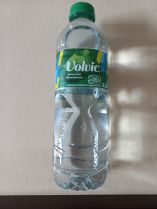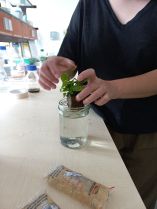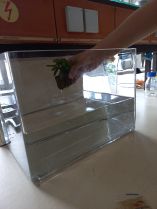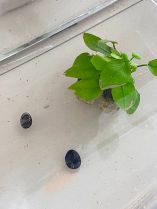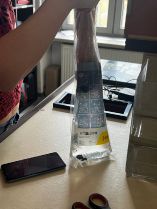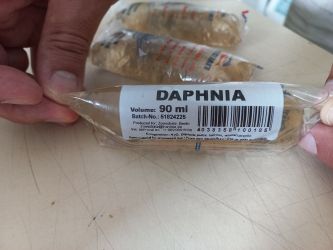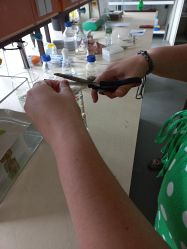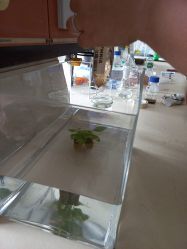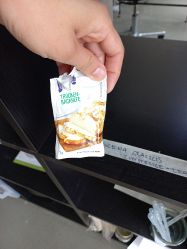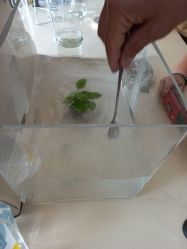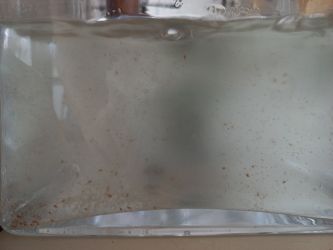Melisaaslan (talk | contribs) (Created page with "thumb|225x225px|'''Image 1.''' Daphnia Pulex, [https://animaldiversity.org/accounts/Daphnia_pulex/pictures/collections/contributors/Grzimek_inverts/Cladocera/Daphnia_pulex/ Image Resource] [DRAFT] '''''Daphnia pulex'',''' although often called water fleas, are freshwater crustaceans closely related to shrimp. Daphnia, the most common microscopic crustacean, can be visible to the naked eye, with lengths ranging from 0.2–5 mm. Their reproduct...") |
Melisaaslan (talk | contribs) No edit summary |
||
| (4 intermediate revisions by the same user not shown) | |||
| Line 1: | Line 1: | ||
[[File:Daphnia Pulex .jpg|thumb| | === 1. Introduction === | ||
[[File:Daphnia Pulex .jpg|thumb|264x264px|'''Image 1.''' Daphnia Pulex, [https://animaldiversity.org/accounts/Daphnia_pulex/pictures/collections/contributors/Grzimek_inverts/Cladocera/Daphnia_pulex/ Image Source]]]'''''Daphnia pulex''''', known as water fleas, are freshwater crustaceans closely related to shrimp. Though microscopic, Daphnia are among the most visible small crustaceans, ranging in size from 0.2 to 5 mm. Their reproduction alternates between asexual and sexual cycles, with females laying eggs in warmer conditions, while males are produced under stressful circumstances like overcrowding or cold temperatures. | |||
Daphnia belongs to the group of metazoans, which also includes nematodes, bristle worms, and tardigrades. Metazoans feed on algae, bacteria, and protozoa, such as amoebas, flagellates, and ciliates, which help regulate bacterial populations, cycle nutrients, and enhance water clarity. Metazoans play a role in controlling protozoa and bacteria levels. | |||
'''Physical Characteristic''' | |||
[[File:Anatomy of Daphnia.png|thumb|210x210px|'''Image 2.''' Anatomy of Daphnia. Science in School. [https://www.scienceinschool.org/article/2022/hands-on-experiments-daphnia/ Image Source]]] | |||
Daphnia pulex has a characteristic translucent carapace, which allows scientists to observe internal processes such as heart rate, digestion, and reproduction in real time. Daphnia has a simple, open circulatory system with a single, small heart located dorsally. The heart rate is susceptible to changes in environmental factors such as temperature and oxygen levels, which makes them useful for toxicological studies. | |||
''' | '''Environmental Factors''' | ||
Daphnia are highly sensitive to oxygen levels, the pH and the temperature of the water. When the oxygen is low, they may suffer physiological stress, which affects their heart rate and survival. Cooler temperatures slow their metabolism and reproduction. Acidic or fundamental conditions can be detrimental to their survival. They prefer a neutral to slightly alkaline pH and can be sensitive to changes in water hardness and salinity. | |||
[[File:Daphnia | '''Life Cycle and Reproduction''' | ||
[[File:The Reproduction Cycle of Daphnia.png|thumb|203x203px|'''Image 3'''. The reproduction cycle of Daphnia magna. [https://doi.org/10.1007/s11356-023-26169-0 Image Source]]] | |||
For most of the year, especially in favourable conditions, female Daphnia pulex reproduce through '''parthenogenesis''', producing genetically identical offspring. This allows rapid population growth, which is crucial for their survival in fluctuating environments. | |||
When environmental conditions become unfavourable, like in colder temperatures or overcrowded populations, Daphnia shifts to '''sexual reproduction.''' This involves producing males and mating to form resting eggs or ephippia. These eggs are capable of surviving extreme conditions like drying out or freezing, allowing the species to persist through harsh periods. | |||
=== '''2. Setting Up the Aquarium''' === | |||
A small aquarium was used to contain the daphnia. | |||
For the water requirement, 1.5L Volvic brand mineral water was used to maintain the pH between '''6.5 and 8.5'''. Since Daphnia are sensitive to chlorine, the water must be dechlorinated water. | |||
'''The water plant''' and '''the snails''' were placed to regulate the oxygen inside the water and to filter. | |||
Also, the water temperature must be between '''18°C to 25°C''', therefore, the tank was placed in the daylight in the lab to provide sufficient conditions. | |||
[[File:Daphnia 9.jpg|frameless|210x210px]] [[File:Daphnia 8.jpg|frameless|210x210px]] [[File:Daphnia 5.jpg|frameless|210x210px]] [[File:Snails.jpg|frameless|210x210px]] [[File:Daphnia 11.jpg|frameless|210x210px]] | |||
. | === 3. Introducing the Culture === | ||
3x90 ml Daphnia culture was introduced to the tank. | |||
... | [[File:Daphnia 7.jpg|frameless|333x333px]] [[File:Daphnia 6.jpg|frameless|250x250px]] [[File:Daphnia 4.jpg|frameless|250x250px]] | ||
=== 4. Feeding the Daphnia === | |||
2-3 small pinch of '''baker’s yeast''' were dissolved in water. Afterwards, the water started to get cloudy. | |||
[[File:Yeast Daphnia.jpg|frameless|250x250px]] [[File:Daphnia 2.jpg|frameless|250x250px]] [[File:Daphnia 1.jpg|frameless|333x333px]] | |||
The culture was fed every 1-2 days. | |||
=== 5. Troubleshooting === | |||
Unfortunately, the amount of yeast caused the overfeeding of fleas. For the further process, the amount of it must be less than before and the water clarity should be taken into consideration to avoid overfeeding. | |||
| Line 47: | Line 50: | ||
''Documentation by'' Melisa Aslan | ''Documentation by'' Melisa Aslan | ||
'''<small>References</small>''' | === '''<small>6. References</small>''' === | ||
<small>Colbourne, J.K., et al. (2011). ''The Ecoresponsive Genome of Daphnia pulex''. ''Science'', 331(6017), 555-561.</small> | |||
<small>Daphnia pulex. (n.d.-b). Retrieved on 06.09.2024 from https://cfb.unh.edu/cfbkey/html/Organisms/CCladocera/FDaphnidae/GDaphnia/Daphnia_pulex/daphniapulex.html</small> | |||
<small>'' | <small>Guo, J., Ren, J., Chang, C., Duan, Q., Li, J., Kanerva, M., Yang, F., & Mo, J. (2023). Freshwater crustaceans exposed to active pharmaceutical ingredients: ecotoxicological effects and mechanisms. ''Environmental Science and Pollution Research'', ''30''(17), 48868–48902. Retrieved on 06.09.2024 from https://doi.org/10.1007/s11356-023-26169-0</small> | ||
<small>Hill, P. (2022, August 17). Lagoon Water fleas as indicator organisms: About Daphnia | Triplepoint Environmental. ''Triplepoint Environmental''. Retrieved on 06.09.2024 from https://lagoons.com/blog/algae/lagoon-water-fleas/</small> | <small>Hill, P. (2022, August 17). Lagoon Water fleas as indicator organisms: About Daphnia | Triplepoint Environmental. ''Triplepoint Environmental''. Retrieved on 06.09.2024 from https://lagoons.com/blog/algae/lagoon-water-fleas/</small> | ||
<small>Science in School. (2024, June 26). ''From drugs to climate change: hands-on experiments with Daphnia as a model organism – Science in School''. Retrieved on 06.09.2024 from https://www.scienceinschool.org/article/2022/hands-on-experiments-daphnia/</small> | |||
<small>Wikipedia. (2023, December 3). ''Daphnia pulex''. Retrieved on 06.09.2024 from https://en.wikipedia.org/wiki/Daphnia_pulex</small> | <small>Wikipedia. (2023, December 3). ''Daphnia pulex''. Retrieved on 06.09.2024 from https://en.wikipedia.org/wiki/Daphnia_pulex</small> | ||
Latest revision as of 11:22, 21 September 2024
1. Introduction
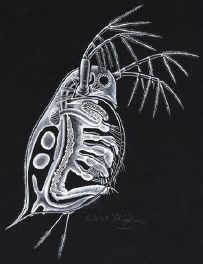
Daphnia pulex, known as water fleas, are freshwater crustaceans closely related to shrimp. Though microscopic, Daphnia are among the most visible small crustaceans, ranging in size from 0.2 to 5 mm. Their reproduction alternates between asexual and sexual cycles, with females laying eggs in warmer conditions, while males are produced under stressful circumstances like overcrowding or cold temperatures.
Daphnia belongs to the group of metazoans, which also includes nematodes, bristle worms, and tardigrades. Metazoans feed on algae, bacteria, and protozoa, such as amoebas, flagellates, and ciliates, which help regulate bacterial populations, cycle nutrients, and enhance water clarity. Metazoans play a role in controlling protozoa and bacteria levels.
Physical Characteristic

Daphnia pulex has a characteristic translucent carapace, which allows scientists to observe internal processes such as heart rate, digestion, and reproduction in real time. Daphnia has a simple, open circulatory system with a single, small heart located dorsally. The heart rate is susceptible to changes in environmental factors such as temperature and oxygen levels, which makes them useful for toxicological studies.
Environmental Factors
Daphnia are highly sensitive to oxygen levels, the pH and the temperature of the water. When the oxygen is low, they may suffer physiological stress, which affects their heart rate and survival. Cooler temperatures slow their metabolism and reproduction. Acidic or fundamental conditions can be detrimental to their survival. They prefer a neutral to slightly alkaline pH and can be sensitive to changes in water hardness and salinity.
Life Cycle and Reproduction

For most of the year, especially in favourable conditions, female Daphnia pulex reproduce through parthenogenesis, producing genetically identical offspring. This allows rapid population growth, which is crucial for their survival in fluctuating environments.
When environmental conditions become unfavourable, like in colder temperatures or overcrowded populations, Daphnia shifts to sexual reproduction. This involves producing males and mating to form resting eggs or ephippia. These eggs are capable of surviving extreme conditions like drying out or freezing, allowing the species to persist through harsh periods.
2. Setting Up the Aquarium
A small aquarium was used to contain the daphnia.
For the water requirement, 1.5L Volvic brand mineral water was used to maintain the pH between 6.5 and 8.5. Since Daphnia are sensitive to chlorine, the water must be dechlorinated water.
The water plant and the snails were placed to regulate the oxygen inside the water and to filter.
Also, the water temperature must be between 18°C to 25°C, therefore, the tank was placed in the daylight in the lab to provide sufficient conditions.
3. Introducing the Culture
3x90 ml Daphnia culture was introduced to the tank.
4. Feeding the Daphnia
2-3 small pinch of baker’s yeast were dissolved in water. Afterwards, the water started to get cloudy.
The culture was fed every 1-2 days.
5. Troubleshooting
Unfortunately, the amount of yeast caused the overfeeding of fleas. For the further process, the amount of it must be less than before and the water clarity should be taken into consideration to avoid overfeeding.
Documentation by Melisa Aslan
6. References
Colbourne, J.K., et al. (2011). The Ecoresponsive Genome of Daphnia pulex. Science, 331(6017), 555-561.
Daphnia pulex. (n.d.-b). Retrieved on 06.09.2024 from https://cfb.unh.edu/cfbkey/html/Organisms/CCladocera/FDaphnidae/GDaphnia/Daphnia_pulex/daphniapulex.html
Guo, J., Ren, J., Chang, C., Duan, Q., Li, J., Kanerva, M., Yang, F., & Mo, J. (2023). Freshwater crustaceans exposed to active pharmaceutical ingredients: ecotoxicological effects and mechanisms. Environmental Science and Pollution Research, 30(17), 48868–48902. Retrieved on 06.09.2024 from https://doi.org/10.1007/s11356-023-26169-0
Hill, P. (2022, August 17). Lagoon Water fleas as indicator organisms: About Daphnia | Triplepoint Environmental. Triplepoint Environmental. Retrieved on 06.09.2024 from https://lagoons.com/blog/algae/lagoon-water-fleas/
Science in School. (2024, June 26). From drugs to climate change: hands-on experiments with Daphnia as a model organism – Science in School. Retrieved on 06.09.2024 from https://www.scienceinschool.org/article/2022/hands-on-experiments-daphnia/
Wikipedia. (2023, December 3). Daphnia pulex. Retrieved on 06.09.2024 from https://en.wikipedia.org/wiki/Daphnia_pulex
